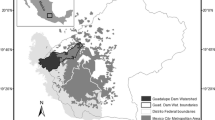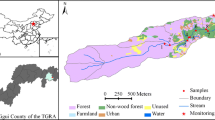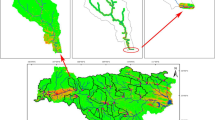Abstract
Finnish arable land is typically located on flat areas, where the fields are mostly drained and sub-drained to control the water tables. These areas are highly susceptible to nutrient loss, which affects the water quality of rivers and lakes. Therefore, it is very important to understand current landscape pattern and processes controlling water quality, not only identifying factors affecting it, but also identifying strategies and restoring areas for mitigation. We studied linkage of 21 years (1990–2011) of water quality (WQ) data from 16 agricultural watersheds, using landscape indices at three functional scales: watershed-wide, saturation-excess zone, and riparian zone (of varying widths). The hydro-biogeochemical functional areas of watershed were obtained by digital terrain analysis. Statistical analyses by generalized linear model and multivariate redundancy analysis indicated that the fraction of watershed in agricultural use was linked to most of the studied water quality variables. The relationships varied across the seasons: they were strongest during high flow periods (spring and autumn) when also highest nutrient losses occur. Total suspended sediment concentrations were linked to critical source areas. Riparian vegetation index was important explaining nitrate concentrations in autumn. Terrain-based mapping of hydro-biogeochemical functional areas provides a rapid identification of potential sites to mitigate diffuse nutrient pollution, particularly in riparian zones.








Similar content being viewed by others
References
Amiri BJ, Nakane K (2009) Modeling the linkage between river water quality and landscape metrics in the Chugoku District of Japan. Water Resour Manag 23(5):931–956
Arango CP, Tank JL (2008) Land use influences the spatiotemporal controls of nitrification and denitrification in headwater streams. J N Am Benthol Soc 27:90–107
Baker ME, Weller DE, Jordan TE (2006) Improved methods for quantifying potential nutrient interception by riparian buffers. Landsc Ecol 21:1327–1345
Baker ME, Weller DE, Jordan TE (2007) Effects of stream map resolution on measures of riparian buffer distribution and nutrient retention potential. Landsc Ecol 22:973–992
Billy C, Birgand F, Ansart P, Peschard J, Sebilo M, Tournebize J (2013) Factors controlling nitrate concentrations in surface waters of an artificially drained agricultural watershed. Landsc Ecol. doi:10.1007/s10980-013-9872-2
Blann KL, Anderson JL, Sands GR, Vondracek B (2009) Effects of agricultural drainage on aquatic ecosystems: a review. Crit Rev Environ Sci Technol 39(11):909–1001
Böhner J, McCloy KR, Strobl J (2006) System for Automated Geoscientific Analyses (SAGA) – Analysis and Modelling Applications, Vol 115. Göttinger Geographische Abhandlungen
Burt TP, Pinay G (2005) Linking hydrology and biogeochemistry in complex landscapes. Prog Phys Geogr 29(3):297–316
Clerici N, Weissteiner CJ, Paracchini ML, Boschetti L, Baraldi A, Strobl P (2013) Pan-european distribution modelling of stream riparian zones based on multi-source earth observation data. Ecol Indic 24:211–223
Creed IF, Sass GZ (2011) Digital terrain analysis approaches for tracking hydrological and biogeochemical pathways and processes in forested landscapes. In: Levia D, Carlyle-Moses D, Tanaka T (eds) Forest hydrology and biogeochemistry: synthesis of past research and future directions. Springer, New York
Ekholm P, Kallio K, Salo S, Pietiläinen OP, Rekolainen S, Laina Y, Joukola M (2000) Relationship between catchment characteristics and nutrient concentrations in an agricultural river system. Water Res 34(15):3709–3716
Grabs T, Seibert J, Bishop K, Laudon H (2009) Modeling spatial patterns of saturated areas: a comparison of the topographic wetness index and a dynamic distributed model. J Hydrol 373:15–23
Griffis V, Stedinger J (2007) Log-Pearson type 3 distribution and its application in flood frequency analysis. I: distribution characteristics. J Hydrol Eng 12(5):482–491
Guo QH, Ma KM, Yang L, He K (2010) Testing a dynamic complex hypothesis in the analysis of land use impact on lake water quality. Water Resour Manag 24:1313–1332
Haygarth PM, Jarvis SC (2002) Agriculture, hydrology and water quality. CABI Publishing, UK
He HS, DeZonia BE, Mladenoff DJ (2000) An aggregation index (AI) to quantify spatial patterns of landscapes. Landsc Ecol 15:591–601
HELCOM (2004) The fourth Baltic Sea pollution load compilation (PLC-4), Baltic Sea environment proceedings No 93. Commission- Baltic Marine Environment Protection Commission, Helsinki
Lane SN, Reaney SM, Heathwaite AL (2009) Representation of landscape hydrological connectivity using a topographically driven surface flow index. Water Resour Res 45:W08423. doi:10.1029/2008WR007336
Legendre P, Oksanen J, ter Braak CJF (2011) Testing the significance of canonical axes in redundancy analysis. Methods Ecol Evol 2(3):269–277
Lepistö A, Kenttämies K, Rekolainen S (2001) Modeling combined effect of forestry, agriculture and deposition on nitrogen export in a northern river basin in Finland. Ambio 30(6):338–348
Lovell ST, Sullivan WC (2006) Environmental benefits of conservation buffers in the United States: Evidence, promise, and open questions. Agric Ecosyst Environ 112(4):249–260
McDowell RW, Srinivasan MS (2009) Identifying critical source areas for water quality: 2. validating the approach for phosphorus and sediment losses in grazed headwater catchments. J Hydrol 379:68–80
Mengistu SG, Creed IF, Webster KL, Enanga E, Beall FD (2013) Searching for similarity in topographic controls on carbon, nitrogen and phosphorus export from forested headwatercatchments. Hydrol Process. doi:10.1002/hyp.9862
Neal C, Jarvie HP (2005) Agriculture, community, river eutrophication and the Water Framework. Directiv Hydrol. Process. (19): 1895–1901
Paasonen-Kivekäs M, Koivusalo H (2006) Losses of sediment and phosphorus through subsurface drains in a clayey field in southern Finland. In: Tamm T, Pietola L (ed) Transport and retention of pollutants from different production systems, Report Vol.2 No 5. Nordic Association of Agricultural Scientistic -NJF
Pionke HB, Gburek AN, Sharpley AN, Schnabel RR (1996) Flow and nutrient export patterns for an agri- cultural hill-land watershed. Water Resour Res 32(6):1795–1804
Pionke HB, Gburek WJ, Sharpley AN (2000) Critical source area controls on water quality in an agricultural watershed located in the Chesapeake Basin. Ecol Eng 14:325–335
Planchon OF, Darboux (2001) A fast, simple and versatile algorithm to fill the depressions of digital elevation models. Catena 46:159–176
Puustinen M, Tattari S, Koskiaho J, Linjama J (2007) Influence of seasonal and annual hydrological variations on erosion and phosphorus transport from arable areas in Finland. Soil Tillage Res 93(1):44–55
R Core Team (2014) R: A Language and Environment for Statistical Comput- ing. Vienna, Austria: R Foundation for Statistical Computing. http://www.R-project.org. Accessed 10 Oct 2014
Ranalli AJ, Macalady DL (2010) The importance of the riparian zone and in-stream processes in nitrate attenuation in undisturbed and agricultural watersheds – a review of the scientific literature. J Hydrol 389:406–415
Roley SS, Tank JL, Williams MA (2012) Hydrologic connectivity increases denitrification in the hyporheic zone and restored floodplains of an agricultural stream. J Geophys Res 117:G00N04. doi:10.1029/2012JG001950
Sharpley AN, Kleinman PJA, Heathwaite AL, Gburek WJ, Weld JL, Folmar GJ (2008) Integrating contributing areas and indexing phosphorus loss from agricultural watersheds. J Environ Qual 37:1488–1496
Singh P, Wu JQ, McCool DK, Dun S, Lin C, Morse JR (2009) Winter hydrological and erosion processes in the U. S. Palouse region: field experimentation and WEPP simulation. Vadose Zone J 8(2):426–436
Sliva L, Williams DD (2001) Buffer zone versus whole catchment approaches to studying land use impact on river water quality. Water Res 35(14):3462–3472
Sørensen R, Zinko U, Seibert J (2006) On the calculation of the topographic wetness index: evaluation of different methods based on field observations. Hydrol Earth Syst Sci 10:101–112
Sucksdorff Y, Teiniranta R (2001) Land cover and land use mapping in Finland. In: Groom G, Reed T (eds) Strategic landscape monitoring for the Nordic countries. Temanord Environment, Copenhagen, pp 89–93
Temme AJAM, Verburg PH (2011) Mapping and modelling of changes in agricultural intensity in Europe. Agric Ecosyst Environ 140(2011):46–56
Turtola E, Paajanen A (1995) Influence of improved subsurface drainage on phosphorus losses and nitrogen runoff from a heavy clay soil. Agric Water Manag 28:295–310
Ulén B, Mattsson L (2003) Transport of phosphorus forms and of nitrate through a clay soil under grass and cereal production. Nutr Cycl Agroecosyst 65:129–140
Uuemaa E, Roosaare J, Mander U (2005) Scale dependence of landscape metrics and their indicatory value for nutrient and organic matter losses from catchments. Ecol Indic 5:350–369
Uusi-Kämppä J, Jauhiainen L (2010) Long-term monitoring of buffer zone efficiency under different cultivation techniques in boreal conditions. Agric Ecosyst Environ 137(1–2):75–85
Uusitalo R, Turtola E, Lemola R (2007a) Phosphorus losses from a subdrained clayey soil as affected by cultivation practices. Agric Food Sci 16(4):352–365
Uusitalo R, Turtola E, Grönroos J, Kivistö J, Mäntylahti V, Turtola A, Lemola R, Salo T (2007b) Finnish trends in phosphorus balance and soil test phosphorus. Agric Food Sci 16(4):301–316
Ventelä AM, Kirkkala T, Lendasse A, Tarvainen M, Helminen H, Sarvala J (2011) Climate-related challenges in long-term management of Säkylän Pyhäjärvi (SWFinland). Hydrobiologia 660(1):49–58
Vidon P, Allan C, Burns D, Duval TP, Gurwick N, Inamdar S, Lowrance R, Okay J, Scott D, Sebestyen S (2010) Hot spots and hot moments in riparian zones: potential for improved water quality management. J Am Water Resour Assoc 46(2):278–298
Vuorenmaa J, Rekolainen S, Lepistö A, Kenttämies K, Kauppila P (2002) Losses of nitrogen and phosphorus from agricultural and forest areas in Finland during the 1980s and 1990s. Environ Monit Assess 76:213–248
Yang J, Dilts TE, Condon LA, Turner PL, Weisberg PJ (2011) Longitudinal- and transverse-scale environmental influences on riparian vegetation across multiple levels of ecological organization. Landsc Ecol 26:381–395
Zuur AF, Leno EN, Smoth GM (2007) Analysing ecological data. Springer, New York
Acknowledgment
Funding for this research was provided by Turku University Foundation and Maj and Tor Nessling Foundation. EU REFRESH project (FP7-ENV-2009-1/244121) is also acknowledged for research support.
Author information
Authors and Affiliations
Corresponding author
Rights and permissions
About this article
Cite this article
Gonzales-Inca, C.A., Kalliola, R., Kirkkala, T. et al. Multiscale Landscape Pattern Affecting on Stream Water Quality in Agricultural Watershed, SW Finland. Water Resour Manage 29, 1669–1682 (2015). https://doi.org/10.1007/s11269-014-0903-9
Received:
Accepted:
Published:
Issue Date:
DOI: https://doi.org/10.1007/s11269-014-0903-9




